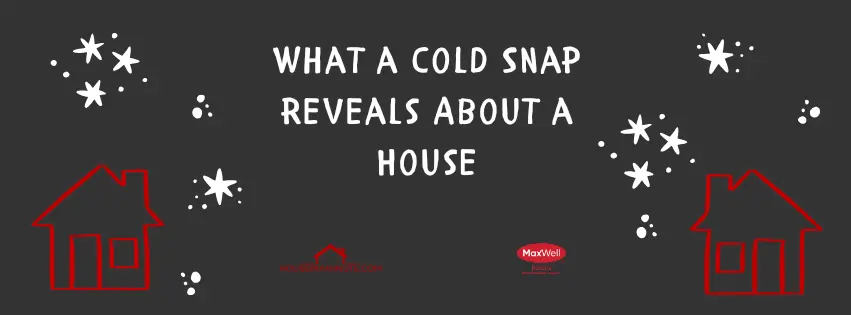What a Cold Snap Reveals About a House
House hunting Edmonton Real Estate in the fall offers more than just scenic drives through colorful foliage. An unexpected cold snap during this season can be a home buyer's secret weapon, revealing potential issues that might otherwise stay hidden until after the papers are signed. A sudden drop in temperature puts a house under stress, making it an ideal time for a savvy buyer to assess its true condition. This guide will walk you through what to look for when a chill is in the air, helping you make a smarter, more informed purchase.
Why a Cold Snap Is a Buyer's Best Friend
When the temperature drops suddenly, a house's systems are put to the test. The heating kicks on, drafts become more apparent, and vulnerabilities in the structure are exposed. While sellers might prefer to show their homes on a sunny, mild day, a cold day provides a more realistic picture of what it's like to live there during the winter months. Paying close attention during a chilly showing can help you identify costly problems and give you significant leverage during negotiations.
Key Areas to Inspect During a Cold Snap
When viewing a home on a cold day, focus your attention on the areas most affected by the temperature change. These spots can offer valuable clues about the home's overall health and energy efficiency.
Insulation and Drafts
One of the most immediate things you can feel in a home during a cold snap is its ability to retain heat.
- Feel the Walls: Place your hand on exterior-facing walls. If they feel significantly colder than interior walls, it could be a sign of poor or nonexistent insulation. This is especially common in older homes.
- Check the Attic: If you can, take a peek into the attic. Look for a thick, even layer of insulation across the attic floor. Gaps, thin spots, or matted-down insulation mean the home is losing a significant amount of heat through the roof, leading to higher energy bills.
- Listen for Drafts: Walk around the house and pay close attention to windows and doors. Can you feel a draft? See if curtains are subtly moving. A noticeable draft indicates poor sealing around windows and door frames, which can be a simple fix or a sign that expensive replacements are needed. Run your hand along the edges of windows and door frames to feel for cold air seeping in.
Heating System Performance
A cold day is the perfect opportunity to see the furnace or heating system in action.
- Turn Up the Heat: Ask for the thermostat to be turned up and listen to the system. Does it make any unusual noises like banging, rattling, or squealing? These sounds can indicate a failing motor or other mechanical issues.
- Check the Vents: As the heat kicks on, walk from room to room and hold your hand over the vents. Is warm air flowing consistently and strongly from each one? Weak airflow in certain rooms could point to ductwork problems, blockages, or an undersized system that struggles to heat the entire house.
- Note the Age: Ask about the age of the furnace. Most heating systems have a lifespan of 15-20 years. If the unit is approaching the end of its life, you’ll need to budget for a replacement.
Plumbing Vulnerabilities
Cold weather is the enemy of plumbing. While you might not see a burst pipe during a showing, you can look for signs of vulnerability.
- Inspect Exposed Pipes: Check pipes in unheated areas like basements, crawl spaces, and garages. Are they insulated? Exposed, uninsulated pipes are at high risk of freezing and bursting in the winter, which can lead to catastrophic water damage.
- Look for Past Leaks: Keep an eye out for water stains on ceilings and walls, especially below bathrooms or near pipes. Previous leaks could indicate past freezing issues that may not have been properly addressed.
Roof and Exterior Condition
The roof is a home’s first line of defense against the elements. A cold snap can reveal how well it's holding up.
- Look for Ice Dams: If there's been recent precipitation, look along the eaves of the roof for ice dams—ridges of ice that form at the edge. Ice dams prevent melting snow from draining properly, which can force water under the shingles and into the house, causing damage to the roof, gutters, and interior walls. They are often a sign of poor attic insulation and ventilation.
- Check the Gutters: Clogged gutters can exacerbate ice damming. Check if the gutters are clean and properly attached to the house.
Tools and Techniques for a Deeper Look
While your own senses are powerful tools, some issues aren't visible to the naked eye. Using technology and professional expertise can give you a more complete picture.
Thermal Imaging
A thermal imaging camera can be an invaluable tool during a cold-weather inspection. These cameras detect differences in temperature and display them as a color-coded image. This allows you to "see" heat loss around windows, identify gaps in insulation, and even spot moisture that isn't visible on the surface. While you can hire a professional with this equipment, some home inspectors include it as part of their service.
Moisture Meters
Moisture meters are simple, handheld devices that detect moisture levels in materials like drywall, wood, and plaster. During a cold snap, condensation can form on the inside of windows with broken seals or in areas with poor insulation. A moisture meter can confirm the presence of water, helping you identify potential mold problems or water damage.
Professional Home Inspections
No matter how thorough you are, nothing replaces a professional home inspection. A qualified inspector has the training and tools to uncover issues you might miss. Schedule the inspection on a cold day if possible, and be present to ask questions. A good inspector will be happy to walk you through their findings and explain the potential implications.
Questions to Ask the Seller
Your inspection should be paired with direct questions. A transparent seller should be willing to provide answers.
- How old is the heating system, and when was it last serviced?
- What are the average monthly utility costs during the winter? (Ask to see bills.)
- Have you had any issues with pipes freezing or bursting in the past?
- Has there ever been an ice dam on the roof? If so, what was done to fix it?
- When was the insulation last updated?
- Are the windows original to the house?
Turn Findings Into Negotiating Power
If your cold-weather inspection reveals problems, it doesn't necessarily mean you should walk away from the sale. Instead, use the information to your advantage. You can request that the seller make repairs before closing or negotiate a lower price to cover the cost of future fixes. A detailed inspection report provides concrete evidence to support your requests, making it harder for the seller to refuse.
Your Smartest Purchase Awaits
Viewing a house during a cold snap is an opportunity that smart buyers shouldn't overlook. It provides a real-world stress test, exposing weaknesses that might otherwise remain concealed. By paying close attention to insulation, heating systems, and potential leaks, you can gain a deeper understanding of the home's true condition. This knowledge not only protects you from unexpected expenses down the road but also empowers you to negotiate a better deal. So next time you see a cold front in the forecast, consider it the perfect time to go house hunting with your Edmonton Realtor.
Posted by Admin . on

Leave A Comment